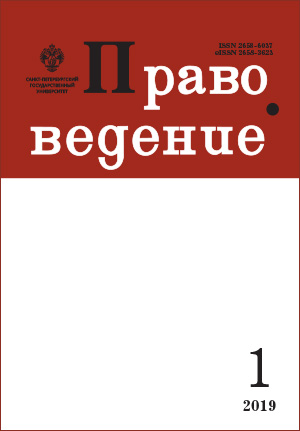Transformation of copyright limitations in the digital age
DOI:
https://doi.org/10.21638/spbu25.2019.105Abstract
In the article, the author analyzes the current state of the Institute of free use and its transformation by changes in social relations and public demand for reforming the system of copyright limitations and exceptions. The author comes to the conclusion that the request to expand the scope of free use is due to the emergence of a number of practices that are perceived as “legitimate” in society, but violate the provisions of current legislation. Such practices include the use of orphan works and the creation and use of fan works. At the same time, the author identifies three factors as prerequisites for this public request, firstly, it is simplification of the information processing (technological prerequisite), secondly, technology leads to a social request to use copyright objects in a certain way (social prerequisite ), thirdly, the inability to make such use due to the current legal regulation (legal prerequisite). After analyzing the impact of this request, the author concludes that there is a tendency to deviate from the traditional form of a list of restrictions on a closed type and the establishment of open restrictions. This tendency is manifested, firstly, in attempts to reconcile the provisions of the three-step test and the doctrine of fair use, and, secondly, in Russian law in expanding the practice of prohibiting abuse of rights and broad interpretation by courts of existing narrow restrictions by the admissibility of citation of not only the text, but any legally published work. The author notes that the desire to expand the practice of applying an open system of restrictions of exclusive rights is due to its flexibility. Such a system allows courts to adopt legal regulations to fast-changing public relations. Meanwhile, the establishment of restrictions of the exclusive right under the open model carries the risk of legal uncertainty. To solve this problem, the author proposes to use open restrictions of exclusive rights, along with the establishment of special restrictions. This will increase legal certainty in established areas of free use and retain the possibility of adapting the institution of free use to new challenges.
Keywords:
copyright, exclusive right, limitations and exceptions, free use, orphan works, fan creativity
Downloads
References
References
Belleflamme, Paul, Peitz, Martin. 2014. Digital piracy. New York, Springer. https://doi.org/10.1007/978-1-4614-7883-6_13-1
Bradrick N. Laura. 2012. Copyright-Don’t Forget About the Orphans: A Look at a (Better) Legislative Solution to the Orphan Works Problem. Western New England Law Review 34 (1): 537–578.
Budnik, Ruslan A. 2015. The civilistic concept of an inclusive mechanism of civil law regulation of copyright relations. Dr. Sci. thesis in Law. Moscow, Rossiiskaia gosudarstvennaia akademiia intellektual’noi sobstvennosti. (In Russian)
Davies, William, Withers, Kay. 2006. Public Innovation. Intellectual Property in a Digital Age. Montreal, Institute for Research in Public Policy.
Kal’iatin, Vitalii O. 2015. Instruments of Public Domain in Modern Information Society. Pravo: zhurnal Vysshei shkoly ekonomiki 4: 4–14. (In Russian)
Lepage, Anne. 2003. Overview of exceptions and limitations to copyright in the digital environment. Copyright Bulletin. Available at: http://unesdoc.unesco.org/images/0013/001396/139696E.pdf (accessed: 15.02.2018).
Lifshitz-Goldberg, Yael. 2010. Orphan Works. WIPO Seminar May 2010. Lecture Summary. World Intellectual Property Organization, WIPO. Available at: http://www.wipo.int/edocs/mdocs/sme/en/wipo_smes_ge_10/wipo_smes_ge_10_ref_theme11_02.pdf (accessed: 15.02.2018).
Novoselova, Liudmila A. (ed.) 2017. Intellectual property law: textbook. Moscow, Statut Publ. (In Russian)
Patry, William. 2012. Patry on Fair Use. New York, Thomson West.
Pavlova, Elena A. (ed.) 2018. Commentary to the fourth part of the Civil Code of the Russian Federation. Moscow, Issledovatel’skii tsentr chastnogo prava im. S. S. Alekseeva pri Prezidente RF Publ. (In Russian)
Ringnalda, Allard. 2011. Orphan Works, Mass Rights Clearance, and Online Libraries: The Flaws of the Draft Orphan Works Directive and Extended Collective Licensing as a Solution. Medien und Recht International 8: 3–10.
Samuelson, Pamela. 2017. Justifications for Copyright Limitations & Exceptions. Copyright Law in an Age of Limitations and Exceptions, ed. by Ruth Okediji. Cambridge University Press.
Sergeev, Alexander P. (ed.) 2015. Commentary on the Civil Code of the Russian Federation. Part Four. Educational and practical commentary. Moscow, Prospekt Publ. (In Russian)
Sitdikova, Roza I. 2013. Limitations of exclusive rights in the mechanism of copyright protection. Rossiiskii iuridicheskii zhurnal 1: 126–130. (In Russian)
Vetulani, Agnieszka. 2008. The Problem of Orphan Works in the EU. An overview of legislative solutions and main actions in this field. European Commission DG Information Society and Media Unit E4: Digital Libraries and Public Sector Information. Available at: http://citeseerx.ist.psu.edu/viewdoc/download?doi=10.1.1.178.8855&rep=rep1&type=pdf (accessed: 15.02.2018).
Voinikanis, Elena A. 2015. Paradigm approach to the study of intellectual rights. Dr. Sci. thesis in Law Moscow, Vysshaia shkola ekonomiki Publ. (In Russian)
Wilkin, John P. 2011. Bibliographic Indeterminacy and the Scale of Problems and Opportunities of “Rights” in Digital Collection Building. Available at: https://www.clir.org/pubs/ruminations/01wilkin/wilkin.pdf (accessed: 15.02.2018).
Downloads
Published
How to Cite
Issue
Section
License
Articles of "Pravovedenie" are open access distributed under the terms of the License Agreement with Saint Petersburg State University, which permits to the authors unrestricted distribution and self-archiving free of charge.




